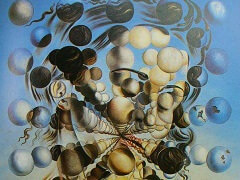Suburbs of a Paranoiac Critical Town, 1936 by Salvador Dali

Salvador Dali continued his 'paranoid-critical' approach, in Suburbs of a Paranoiac Critical Town, which is based on certain motifs in the paintings of Giorgio de Chirico. More importantly, they are also based on the paranoia alluded to in de Chrico's work. In an earlier preparatory drawing for this work, Dali included a young girl skipping, redolent of the girl in de Chirico's Mystery and Melancholy of a Street (1914).
Dali's 'paranoid-critical' method was based on the writings of the psychiatrists Georg Kraepelin ond Eugen Bleuler, who earlier in the twentieth century began to formulate theories concerning paranoia and schizophrenia. Dali's particular interest was their assertion that paranoia lends itself to the coherent development of certain errors to which the subject shows a passionate attachment'. In 1932 Freud's book On Narcissism, in which Freud introduce his theory of paranoia was translated, and in 1933 the psychoanalyst Jacques Lacon published two articles in Minotaure on the subject including Paranoid Forms of Experience. However, Locan was also informed by Dali's own 1930 writing on the subject, L'Ane Pourri. For Dali, his 'paranoid-critical' approach, which was meant to destabilize preconceived notions of reality, enabled him to depict objects and scenarios that could have alternative meanings for the viewer.























